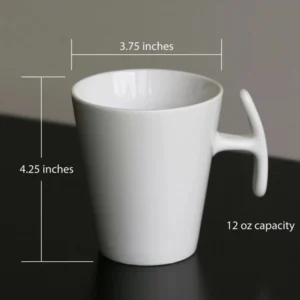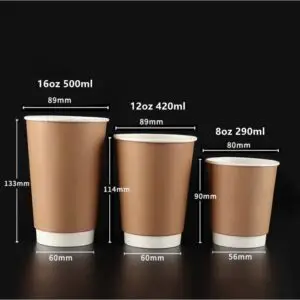Coffee cups are a common and essential part of our daily lives. They are designed to hold hot or cold beverages, with the most common being coffee. Different types of coffee cups have different coffee cup dimensions and characteristics to cater to various needs and preferences.
The standard coffee cup size in the United States is 8 ounces, although there are larger and smaller options available. The dimensions of a typical 8-ounce coffee cup are approximately 3.5 inches in height and 3 inches in diameter.
However, there are many other sizes of coffee cups available, including 12 ounces, 16 ounces, 20 ounces, and even larger ones. These cups are generally taller and wider than the standard 8-ounce cup.
Standard dimensions of coffee cups

Coffee cups come in a wide variety of sizes and shapes, but there are some standard dimensions that are commonly used in the industry. The standard coffee cup size in the United States is 8 ounces, although other sizes are also widely used, such as 12 ounces, 16 ounces, and 20 ounces.
Below, we will discuss the standard dimensions of coffee cups in detail.
Standard 8-Ounce Coffee Cup Dimensions:
Height: The height of a standard 8-ounce coffee cup is approximately 3.5 inches.
Diameter: The diameter of a standard 8-ounce coffee cup is approximately 3 inches.
Volume: The volume of a standard 8-ounce coffee cup is 8 fluid ounces, which is equivalent to 240 milliliters.
Handle: Most standard 8-ounce coffee cups have a handle that is approximately 2.5 inches long and 1 inch wide.
Material: Standard 8-ounce coffee cups can be made of various materials such as ceramic, glass, plastic, or paper.
Standard 12-Ounce Coffee Cup Dimensions:
Height: The height of a standard 12-ounce coffee cup is approximately 4 inches.
Diameter: The diameter of a standard 12-ounce coffee cup is approximately 3 inches.
Volume: The volume of a standard 12-ounce coffee cup is 12 fluid ounces, which is equivalent to 355 milliliters.
Handle: Most standard 12-ounce coffee cups have a handle that is approximately 3 inches long and 1.25 inches wide.
Material: Standard 12-ounce coffee cups can be made of various materials such as ceramic, glass, plastic, or paper.
Standard 16-Ounce Coffee Cup Dimensions:
Height: The height of a standard 16-ounce coffee cup is approximately 5 inches.
Diameter: The diameter of a standard 16-ounce coffee cup is approximately 3.5 inches.
Volume: The volume of a standard 16-ounce coffee cup is 16 fluid ounces, which is equivalent to 473 milliliters.
Handle: Most standard 16-ounce coffee cups have a handle that is approximately 3.5 inches long and 1.5 inches wide.
Material: Standard 16-ounce coffee cups can be made of various materials such as ceramic, glass, plastic, or paper.
Standard 20-Ounce Coffee Cup Dimensions:
Height: The height of a standard 20-ounce coffee cup is approximately 6 inches.
Diameter: The diameter of a standard 20-ounce coffee cup is approximately 3.5 inches.
Volume: The volume of a standard 20-ounce coffee cup is 20 fluid ounces, which is equivalent to 591 milliliters.
Handle: Most standard 20-ounce coffee cups have a handle that is approximately 4 inches long and 1.5 inches wide.
Material: Standard 20-ounce coffee cups can be made of various materials such as ceramic, glass, plastic, or paper.
Overall, the dimensions of a coffee cup depend on its size and shape, and there are several standard sizes available, including 8, 12, 16, and 20 ounces. The most common materials used for coffee cups are ceramic, glass, plastic, and paper, with each having its unique characteristics and benefits.
Comparison of coffee cup sizes from different regions
Coffee cups vary in size from region to region, and it can be confusing to know what size you are getting if you are not familiar with the local standards.
Below, we will compare the sizes of coffee cups from different regions to help you understand the differences.
- North America:
In North America, the most common coffee cup size is 8 ounces, which is equivalent to 240 milliliters. However, larger sizes are also available, such as 12 ounces, 16 ounces, and 20 ounces.
- Europe:
In Europe, the standard coffee cup size is smaller than in North America. The most common size is 6 ounces, which is equivalent to 177 milliliters. Larger sizes are also available, such as 8 ounces and 10 ounces.
- Australia and New Zealand:
In Australia and New Zealand, the standard coffee cup size is larger than in Europe but smaller than in North America. The most common size is 8 ounces, which is equivalent to 240 milliliters. Larger sizes are also available, such as 12 ounces and 16 ounces.
- Asia:
In Asia, coffee cup sizes vary widely depending on the country. In Japan, the standard coffee cup size is small, with a typical size being 5.5 ounces, which is equivalent to 162 milliliters. In China, larger sizes are more common, with 12-ounce cups being the most popular. In South Korea, 6-ounce cups are standard, while in India, 4-ounce cups are commonly used.
- Latin America:
In Latin America, the standard coffee cup size is similar to that of North America. The most common size is 8 ounces, which is equivalent to 240 milliliters, although larger sizes are also available.
Different types of coffee cups and their sizes

There are various types of coffee cups, each with unique designs and sizes that cater to specific coffee drinks.
Below, we will discuss different types of coffee cups and their sizes.
- Espresso Cup: An espresso cup is a small, handleless cup designed to hold a single shot of espresso. The standard size for an espresso cup is 2 to 3 ounces, which is equivalent to 59 to 89 milliliters.
- Demitasse Cup: A demitasse cup is a small cup with a handle used for serving Turkish coffee, espresso, and other strong coffee drinks. The standard size for a demitasse cup is 2.5 to 3.5 ounces, which is equivalent to 74 to 103 milliliters.
- Cappuccino Cup: A cappuccino cup is a wide, shallow cup with a handle designed to hold a double shot of espresso and topped with steamed milk and foam. The standard size for a cappuccino cup is 5 to 6 ounces, which is equivalent to 148 to 177 milliliters.
- Latte Cup: A latte cup is a tall, cylindrical cup with a handle designed to hold a double shot of espresso and topped with steamed milk. The standard size for a latte cup is 8 to 10 ounces, which is equivalent to 237 to 296 milliliters.
- Flat White Cup: A flat white cup is similar to a cappuccino cup but with less foam and more steamed milk, making it smoother and creamier. The standard size for a flat white cup is 5 to 6 ounces, which is equivalent to 148 to 177 milliliters.
- Americano Cup: An Americano cup is a large, deep cup designed to hold a double shot of espresso and hot water, creating a drink similar to drip coffee. The standard size for an Americano cup is 8 to 12 ounces, which is equivalent to 237 to 355 milliliters.
- Travel Cup: A travel cup is a reusable cup designed for people who want to enjoy their coffee on the go. Travel cups come in various sizes, but the most common sizes are 12 ounces, 16 ounces, and 20 ounces.
The impact of coffee cup sizes on the drinking experience
Coffee cup sizes can have a significant impact on the drinking experience, affecting factors such as taste, aroma, temperature, and overall satisfaction.
Below, we will explore the impact of coffee cup sizes on the drinking experience.
- Taste: Coffee cup sizes can impact the taste of the coffee by affecting the ratio of coffee to water or milk. For example, using a small espresso cup for a large latte can result in a coffee that is too strong, while using a large cup for a small espresso can result in a weak coffee. The right cup size can enhance the taste and balance of the coffee.
- Aroma: The aroma of coffee can be affected by the size and shape of the cup. A narrower cup can concentrate the aroma, enhancing the overall drinking experience. A larger cup can dilute the aroma and affect the overall sensory experience.
- Temperature: The size of the cup can also impact the temperature of the coffee. A larger cup can cause the coffee to cool faster, while a smaller cup can retain the heat longer. The right cup size can help maintain the temperature and enhance the flavor of the coffee.
- Overall satisfaction: The size and design of the cup can impact the overall satisfaction of the drinking experience. For example, a well-designed and comfortable cup can enhance the enjoyment of the coffee, while a poorly designed or uncomfortable cup can detract from the experience.
How coffee cup dimensions affect the taste of coffee
Coffee cup dimensions can significantly affect the taste of coffee, as they impact the ratio of coffee to water or milk and the temperature of the coffee.
Below, we will explore how coffee cup dimensions affect the taste of coffee.
- The ratio of coffee to water or milk: The size of the coffee cup can impact the ratio of coffee to water or milk, which can significantly affect the taste of the coffee. For example, if you use a large coffee cup for a single shot of espresso, the coffee will be diluted, resulting in a weaker taste. On the other hand, if you use a small cup for a large latte, the coffee will be too strong and overpowering. The right cup size for the specific coffee drink can enhance the taste and balance of the coffee.
- Temperature: The size of the coffee cup can also impact the temperature of the coffee, which can affect the taste. A larger cup can cause the coffee to cool faster, resulting in a less flavorful and enjoyable experience. On the other hand, a smaller cup can retain the heat longer, keeping the coffee at the optimal temperature for a longer period and enhancing the flavor and aroma.
- Aroma: The shape and size of the coffee cup can also impact the aroma of the coffee, which is a critical component of the taste experience. A narrower cup can concentrate the aroma, enhancing the overall drinking experience. A larger cup can dilute the aroma and affect the overall sensory experience.
Factors influencing the size of coffee cups
The size of coffee cups can be influenced by a variety of factors, including:
- Cultural norms: Different cultures may have different expectations about the size of a coffee cup. For example, in some European countries, espresso is traditionally served in small cups, while in the United States, larger cups are more common.
- Market demand: Coffee shops and manufacturers may adjust the size of their cups based on consumer demand. If customers prefer larger cups, companies may increase the size of their standard cups to meet that demand.
- Functionality: The size of a coffee cup can also be influenced by its intended use. For example, travel mugs may be larger to accommodate the needs of people on the go, while smaller cups may be used for espresso shots or for those who prefer smaller portions.
- Price point: The size of a coffee cup can also be influenced by its price point. Larger cups may be more expensive due to the cost of materials and production, while smaller cups may be more affordable.
- Environmental concerns: Some companies may choose to offer smaller cups as a way to reduce waste and promote environmental sustainability. In addition, some consumers may choose to use smaller cups as a way to reduce their carbon footprint.
Overall, the size of a coffee cup can be influenced by a variety of factors, and it is important for coffee shops and manufacturers to consider the preferences and needs of their customers when deciding on the size of their cups.
Popular brands of coffee cups and their sizes
There are many popular brands of coffee cups available, each with its own unique sizes and styles. Here are a few examples:
- Starbucks: Starbucks offers a variety of sizes for their coffee cups, including tall (12 ounces), grande (16 ounces), venti (20 ounces), and trenta (30 ounces). They also offer smaller sizes for espresso shots and cappuccinos.
- Dunkin’ Donuts: Dunkin’ Donuts offers similar sizes to Starbucks, including small (10 ounces), medium (14 ounces), large (20 ounces), and extra-large (24 ounces).
- Yeti: Yeti is known for its durable and insulated travel mugs. Their sizes include the Rambler 14 oz Mug, Rambler 20 oz Tumbler, and Rambler 30 oz Tumbler.
- Bodum: Bodum offers a variety of sizes for their glass coffee cups, including 4 ounces, 8 ounces, 12 ounces, and 15 ounces.
- Hario: Hario is a popular brand for pour-over coffee brewing. Their sizes include the V60-01 (1-2 cups) and V60-02 (1-4 cups) sizes.
These are just a few examples of popular brands and sizes of coffee cups. It’s important to consider your own preferences and needs when selecting a coffee cup, such as the size, material, and style.
Customized coffee cups and their size options
Customized coffee cups are a great way to add a personal touch to your morning coffee routine, as well as for businesses to promote their brand. Here are some popular size options for customized coffee cups:
- 8 oz: An 8 oz coffee cup is a small size and is commonly used for espresso shots, cappuccinos, and other small coffee drinks.
- 12 oz: A 12 oz coffee cup is medium size and is commonly used for drip coffee and other standard coffee drinks.
- 16 oz: A 16 oz coffee cup is a large size and is commonly used for lattes, cappuccinos, and other specialty coffee drinks.
- 20 oz: A 20 oz coffee cup is an extra-large size and is commonly used for iced coffee, frappuccinos, and other cold coffee drinks.
- 24 oz: A 24 oz coffee cup is a jumbo size and is commonly used for large iced coffee drinks, smoothies, and other cold beverages.
It’s important to note that the available size options for customized coffee cups may vary depending on the manufacturer or supplier. Some may offer additional size options, such as 10 oz or 14 oz, while others may only offer a few standard sizes. When ordering customized coffee cups, be sure to check with the supplier for their available size options and any minimum order requirements.
Coffee cup materials and their impact on the size

The materials used to make coffee cups can impact their size and overall design. Here are a few examples:
- Ceramic: Ceramic coffee cups are a popular choice for home use and in coffee shops. They are typically available in a variety of sizes and designs, ranging from small espresso cups to large mugs for drip coffee. Ceramic cups may be thicker and heavier than other materials, which can impact their size and weight.
- Glass: Glass coffee cups are a great option for showcasing the color and texture of your coffee. They are typically available in smaller sizes, such as 4 oz or 8 oz, and may be thinner and more delicate than ceramic or other materials.
- Stainless steel: Stainless steel travel mugs are a popular option for people on the go. They come in a variety of sizes, from small to extra-large, and may have additional features such as insulation to keep coffee hot for longer periods of time. Stainless steel cups may be heavier and bulkier than other materials, which can impact their size and portability.
- Plastic: Plastic coffee cups are a lightweight and affordable option for both home use and in coffee shops. They are available in a variety of sizes and designs and may be more flexible than other materials. However, plastic cups may be less durable and environmentally friendly than other materials.
Overall, the materials used to make coffee cups can impact their size, weight, and overall design. It’s important to consider your own preferences and needs when selecting a coffee cup, such as the size, material, and style.
How to choose the right size coffee cup
Choosing the right size coffee cup can depend on your personal preferences and needs. Here are some factors to consider when selecting a coffee cup size:
- Serving size: Consider the serving size of the coffee drink you typically enjoy. If you prefer small espresso shots or cappuccinos, a smaller 8 oz or 12 oz cup may be sufficient. If you enjoy larger lattes or drip coffee, a 16 oz or 20 oz cup may be a better choice.
- Portability: If you frequently take your coffee on the go, consider a travel mug or insulated cup. These are available in a variety of sizes, ranging from small 8 oz cups to extra-large 30 oz cups.
- Comfort: Consider how comfortable the coffee cup feels in your hand. A larger cup may be heavier and more difficult to hold, while a smaller cup may be too light and easy to tip over.
- Storage: Consider the space available for storing your coffee cups. If you have limited cabinet space, smaller cups may be a better choice.
- Environmental impact: Consider the environmental impact of the materials used to make the coffee cup. Reusable cups, such as travel mugs or insulated cups, can help reduce waste and are available in a variety of sizes.
Ultimately, the right size coffee cup depends on your personal preferences and needs. Consider the serving size, portability, comfort, storage, and environmental impact when selecting a coffee cup size.
Recommended:
Tips for maintaining the size of coffee cups
If you want to maintain the size of your coffee cups, here are some tips:
- Use a measuring cup: Use a measuring cup to measure the amount of coffee you put in your cup. This will help you ensure that you are putting the same amount of coffee in your cup each time.
- Stick to the same cup: Use the same cup every day for your coffee. This will help you get used to the size of the cup and ensure that you are not accidentally using a larger cup.
- Avoid supersizing: Avoid purchasing larger cups or mugs than you need. If you tend to fill up a larger cup, you may end up consuming more coffee than you intended.
- Be aware of serving sizes: Be aware of the recommended serving sizes for coffee. According to the USDA, a serving of coffee is 8 fluid ounces, which is the size of a standard coffee cup.
- Don’t add extra liquid: If you like to add cream, milk, or sugar to your coffee, be mindful of how much you are adding. These additions can add extra liquid to your cup, which can increase the overall size of your drink.
By following these tips, you can help maintain the size of your coffee cups and ensure that you are consuming the recommended serving size of coffee.
Conclusion
If you want to get yourself coffee cups, it is important that you know the coffee cup dimensions to make the right decision. Paying attention to the dimensions of your coffee cups can help you control your coffee consumption and ensure that you are consuming the recommended serving size of coffee.
Using a measuring cup, sticking to the same cup, avoiding supersizing, being aware of serving sizes, and being mindful of any added liquids are all tips that can help you maintain the size of your coffee cups. By following these tips, you can enjoy your coffee while also being mindful of your intake.

